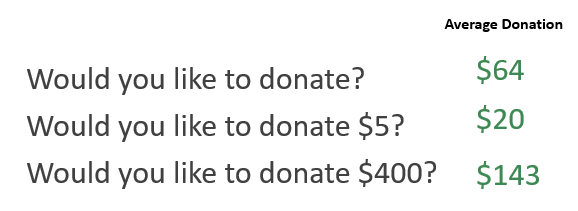Experimenting with Pay What You Will tickets? Check your anchors!

Jamie Alexander
Director, Strategy & Insights
An increasingly popular form of Radical Pricing—pricing designed to promote an extraordinarily welcome environment—is Pay What You Will (PWYW). Performing arts and visitor attractions organizations are increasingly experimenting with this form of pricing, which allows the patron to name a price that they want to pay for the experience.
What we often don’t think about with PWYW pricing is that by asking people to name their price, we are placing a mental burden on them. We are asking them to do a calculation of the value of an experience and balance that with what they can afford to pay.
This can be a difficult task. Remember that humans are not good at assessing absolute value. If you give someone a bag of sand and ask them to tell you how much it weighs, they will struggle to give you an answer. But if you give someone two bags of sand and tell them the weight of the first bag, they will give you a more educated guess as to the weight of second bag, by comparing it to the first. Humans measure the value of things relative to other things, and the same is true for ticket prices.
This is why it’s important in PWYW pricing to provide an anchor price, or a price on which an individual will judge other prices. Here’s an example of an anchor price in the purchase path for a PWYW ticket:

By telling patrons that the average ticket price is $35, this organization is making $35 the anchor price and individuals will identify the price they want to pay in relation to that anchor price. By setting an anchor price, you are relieving some of the patron’s mental burden in deciding a price, and also nudging them towards the price that you want them to pay.
Be careful with how you set your anchor prices, as the anchor will impact the prices that people will pay, even if the anchor is arbitrary (a concept called arbitrary coherence). Here’s an example of arbitrary coherence in a study by Daniel Kahneman, a popular behavioral economist, in his book Thinking Fast and Slow*:
A popular science museum in San Francisco asked visitors if they would make a contribution to help the museum continue its conservation efforts. Some guests were asked a question “Would you like to donate” without a value attached, and some were asked the same question with values attached, such as, “Would you like to donate $5?” or “Would you like to donate $400?”
The results are compelling:

On average, those with the no-value question said that they would donate $64. When they added the value of $5, their donation went down to $20. But, when the requested value was $400, the average donation rose to $143.
This means that you can affect what people pay, or donate, simply based on the power of suggestion. So be careful with your selected anchor price, and make sure it will encourage people to pay the price that will meet your objectives—whether they be for audience development or revenue.
As you experiment with PWYW pricing, keep these concepts of anchor prices and arbitrary coherence in mind. Experiment with different anchor prices—do you see a difference in average price paid or total tickets sold? These experiments will help you to cultivate a PWYW program that relieves your patron of mental burden while also helping meet your attendance and revenue goals.
Do you have questions about Radical Pricing, or need help identifying your organization’s pricing strategy? Start a conversation with one of our consultants!
* Kahneman, Daniel. Thinking, Fast and Slow. Farrar, Straus and Giroux, 2011.

